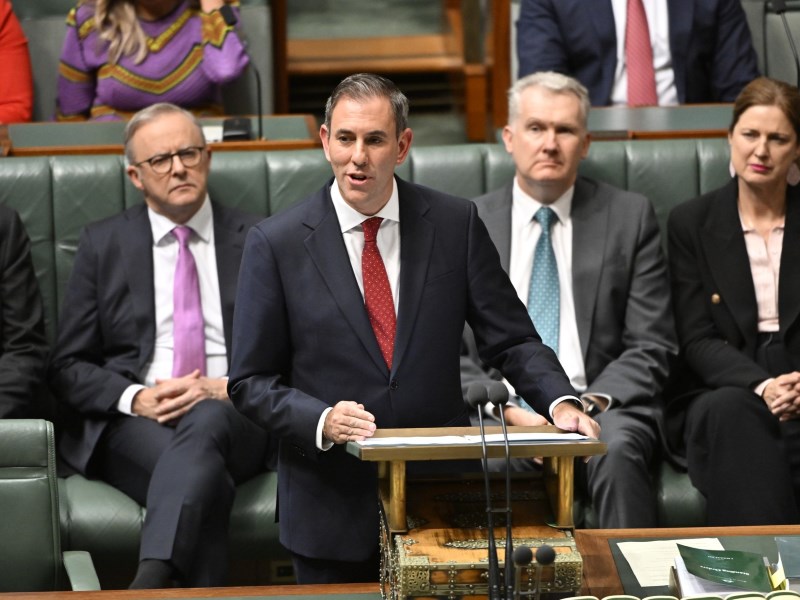For a while it looked like federal Treasurer Jim Chalmers’ Economic Reform Roundtable would turn into a tax summit, such was the clamour to revisit missed opportunities. And we have an abundance of those in Australia.
However, the intended focus on Australia’s lagging productivity performance has appropriately been retained in the current three-day agenda next month with the further topics of “resilience” and budget sustainability, as well as separate roundtables to be convened by other ministers, including Industry and Innovation minister Tim Ayres.
This aligns with Prime Minister Anthony Albanese’s assurance that “tax reform will be an important part of this conversation, but not the whole of it”. The roundtable “is also an opportunity to build consensus around practical measures that can be implemented quickly. Dealing with urgent challenges, in a way that builds for the future”.

Of course, tax reform matters, as former Treasury secretary Ken Henry has tirelessly argued, particularly for addressing the compelling issues of inequality, the energy transition and the safeguarding of our natural environment. But it does not provide an answer to the fundamental problem of Australia’s outdated trade and industrial structure.
Industry structure
The recent interim discussion paper of the government’s Strategic Examination of R&D (SERD) indicates the scope of the problem. It finds an almost exact correlation between the decline of manufacturing, the decline of business expenditure on research and development (R&D) and the decline of productivity growth, now at its lowest level for 60 years.
This should not come as a surprise given that technological change and innovation has been a key driver of productivity and living standards for more than 200 years.
And while correlation is not causation, there is a sufficient body of evidence to suggest that the low level of business R&D intensity in Australia – around half the OECD average at 0.9 per cent of GDP – goes a long way to explaining poor productivity performance.
However, it is not the whole explanation.
As a Treasury research paper pointed out in 2005, “industry structure explains a lot of the difference in R&D intensities between countries”. Specifically, high value manufacturing accounts for most business R&D expenditure in advanced economies and, by contrast with mining, is characterised by increasing returns to scale.
According to the paper, “the role that policy plays in directly influencing R&D expenditure might be secondary to the roles that context and industry structure play”. This conclusion is supported by more recent analysis, which demonstrates the causal link between manufacturing output growth and productivity across a dataset of 52 countries, as well as the role of government in promoting it.
While it might be convenient in current debate to focus on the well-worn arithmetic truism that a larger share of low productivity services contributes to stalled productivity growth (the “Baumol effect”), this would avoid the more problematic story of the hollowing out of manufacturing in Australia to 6 per cent of GDP, the lowest share of any OECD country.
This is a story that owes much to the so-called “Dutch disease”, whereby dollar appreciation due to the commodity boom markedly eroded the competitiveness of Australia’s trade-exposed industries, with a massive loss of high skill jobs, and entrenched the path-dependency of manufacturing decline.
But it was not inevitable, as Norway showed with interventionist policies to reposition its economy with a 76 per cent resource rent tax on North Sea oil and gas exports and a $3 trillion sovereign wealth fund, now the biggest in the world.
Comparative vs competitive advantage
Nor does the story end there as it is also about the rigid application of the doctrine of comparative advantage by successive governments, egged on by economic commentators, which has privileged the export of unprocessed raw materials over the prospect of competitive advantage in more complex, value-adding activities.
Even with world-leading technology, mining industry output is characterised by diminishing returns, which is the motivation for these commentators to exclude mining from recent comparisons of productivity growth in the market and non-market sectors.
According to recent data, primary goods account for more than 80 per cent of Australian goods exports, with manufactures reduced to 15 per cent. And of these primary goods, 98 per cent were in unprocessed form.
This is why Australia ranks 105 out of 145 countries in the Harvard Atlas of Economic Complexity – behind Botswana and Senegal – as measured by the diversity and knowledge-intensity of a country’s export mix.
It is also why addressing the structural deterioration of productivity and associated real wage stagnation requires more than fiddling around the edges with competition policy, removal of “red tape” or even a funding boost to R&D, useful though these measures may be.
The government knows it only gets one chance at game-changing economic reform. So the productivity and growth agenda must be as ambitious as the depth of the problems we face, particularly as Australia’s narrow trade and industrial structure makes us ever more vulnerable to commodity price volatility and supply chain disruption.
Last December, Dr Chalmers charged the Productivity Commission with inquiries into five aspects of this agenda – creating a more dynamic and resilient economy, building a skilled and adaptable workforce, harnessing data and digital technology, delivering quality care more efficiently and investing in cheaper, cleaner energy and the net zero transformation.
These headings provide a well-framed set of challenges for discussion at the various roundtables. Mr Ayres separate but related roundtables will cover minerals and metals processing, industry capability and technology and innovation.
We can only hope the Commission under its new leadership has learnt something from the decades during which they presided over Australia’s poor productivity performance, masked only by a terms of trade boost from commodity prices.
While some maintain that this record is due to the reluctance of governments to follow the Commission’s advice, others have responded that the central themes of deregulation, privatisation and market contestability were followed all too closely, with mostly dismal results.
Industrial strategy
Going forward, what are some of the key design principles and priorities to consider as building blocks for a comprehensive, evidence-based industrial strategy, which both creates and adapts to the technologies and jobs of the future?
The government already has a Future Made in Australia (FMiA) plan for achieving economic resilience and a pathway to net zero. An urgent priority should be to join up this plan with the further development of the research and innovation system so that new industries as well as existing ones can participate effectively in global markets and value chains.
For example, the Industry Capability Network (ICN), which connects small and medium enterprises (SMEs) with large projects, would be in a position to add more value and foster greater business dynamism if it was also funded to promote new technologies, like the US Small Business Innovation Research (SBIR) program.
The ICN is Australia’s longest surviving industrial policy agency and reminds us that the Hawke-Keating era of economic reform through its Accord with the trade union movement was not just about floating the dollar and tariff reductions but also targeted industry plans, structural adjustment measures and workplace best practice programs.
Consequently, a second priority for industrial strategy would be to establish an institutional coordinating focus, along the lines of many other advanced economies, such as Vinnova in Sweden, METI in Japan, InnovateUK and TNO in the Netherlands.
This is long overdue and would address the fragmentation of Commonwealth funding for the research and innovation system across 151 separate budget line items and 14 portfolio areas. It might also streamline the extraordinary multiplicity of business improvement programs – 712 at last count – across both State and federal jurisdictions.
A tripartite mission-led strategy could begin with a “technology foresighting” exercise to identify current and future areas of competitive advantage in consultation with industry, unions and research institutions, including CSIRO. This would enable interventions not just to respond to market failure but to shape markets.
Third, an important emerging theme in submissions to the SERD is that the traditional linear “lab to market” approach to research commercialisation has been or is being superseded by networks of place-based innovation ecosystems.
Examples include the Fraunhofer system in Germany, High Value Manufacturing Catapults in UK and Norway, ManufacturingUSA Institutes and the National Science Foundation (NSF) Regional Innovation Engines. These are proving to be a more effective way to embed industry-research collaboration and attract knowledge-based global investors.
Australia has its own examples of collaborative hubs, such as the Advanced Robotics for Manufacturing (ARM) Hub and UTS Tech Lab, but these are mostly at an embryonic stage. And while Cooperative Research Centres (CRCs) make a valuable contribution, their funding is short-lived, as well as being disconnected from the wider system.
A fourth priority is the vexed issue of finance for industrial transformation, which must be activated and available at all levels of the Technology Readiness Level (TRL) scale, from basic and industry-led research to early-stage ventures through to the scaling of SMEs.
There are already significant financial resources in FMiA and related equity, loan and grant programs established in Labor’s first term of office, not to mention government procurement. But barriers to access and eligibility need to be addressed, along with enterprise “absorptive capacity” on the part of industry.
The superannuation sector also has a responsibility on behalf of both current and future members to diversify its immense asset base from investment in residential housing and overseas share portfolios to building Australia’s sovereign industrial capability.
Finally, management capability and worker voice are critical to productive performance at the enterprise level. Research commissioned by the last Labor government showed that while managers in “frontier” firms are second to none, most lag far behind world best practice.
The area where Australian managers lagged most was in a category headed “instilling a talent mindset”, in other words the ability to draw on the talent and creativity of workforces. This has for decades been a defining feature of the “quality movement”, but one currently lost in the distracting focus on penalty rates.
Clearly, training and education are essential for building workforce and management capability, but so is the need for employees and their representatives to be involved in the decisions affecting them, including the deployment and use of artificial intelligence.
Productivity may be an elusive concept, but it remains critical to the future of Australia’s economy and its people. The Albanese government has an historic opportunity to remake our trade and industrial structure for a world of rapid technological change and shifting geopolitical alliances. It should not be missed.
Emeritus Professor Roy Green is special innovation advisor at the University of Technology Sydney
Do you know more? Contact James Riley via Email.

